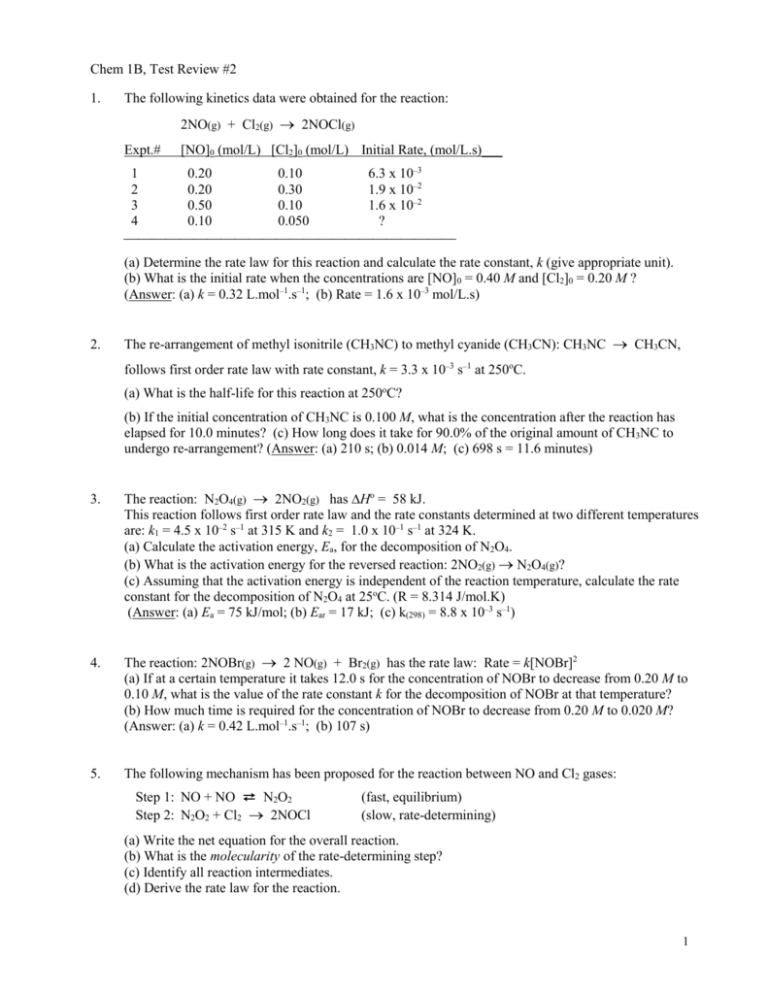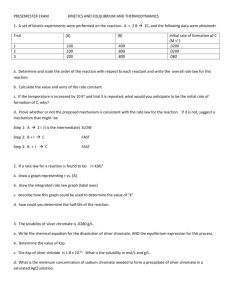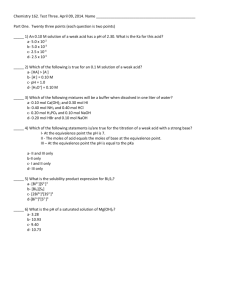Chem 1B TestReview#2 - Berkeley City College
advertisement

Chem 1B, Test Review #2 1. The following kinetics data were obtained for the reaction: 2NO(g) + Cl2(g) 2NOCl(g) Expt.# [NO]0 (mol/L) [Cl2]0 (mol/L) Initial Rate, (mol/L.s)___ 1 0.20 0.10 6.3 x 10–3 2 0.20 0.30 1.9 x 10–2 3 0.50 0.10 1.6 x 10–2 4 0.10 0.050 ? (a) Determine the rate law for this reaction and calculate the rate constant, k (give appropriate unit). (b) What is the initial rate when the concentrations are [NO]0 = 0.40 M and [Cl2]0 = 0.20 M ? (Answer: (a) k = 0.32 L.mol–1.s–1; (b) Rate = 1.6 x 10–3 mol/L.s) 2. The re-arrangement of methyl isonitrile (CH3NC) to methyl cyanide (CH3CN): CH3NC CH3CN, follows first order rate law with rate constant, k = 3.3 x 10–3 s–1 at 250oC. (a) What is the half-life for this reaction at 250oC? (b) If the initial concentration of CH3NC is 0.100 M, what is the concentration after the reaction has elapsed for 10.0 minutes? (c) How long does it take for 90.0% of the original amount of CH3NC to undergo re-arrangement? (Answer: (a) 210 s; (b) 0.014 M; (c) 698 s = 11.6 minutes) 3. The reaction: N2O4(g) 2NO2(g) has Ho = 58 kJ. This reaction follows first order rate law and the rate constants determined at two different temperatures are: k1 = 4.5 x 10–2 s–1 at 315 K and k2 = 1.0 x 10–1 s–1 at 324 K. (a) Calculate the activation energy, Ea, for the decomposition of N2O4. (b) What is the activation energy for the reversed reaction: 2NO2(g) N2O4(g)? (c) Assuming that the activation energy is independent of the reaction temperature, calculate the rate constant for the decomposition of N2O4 at 25oC. (R = 8.314 J/mol.K) (Answer: (a) Ea = 75 kJ/mol; (b) Ear = 17 kJ; (c) k(298) = 8.8 x 10–3 s–1) 4. The reaction: 2NOBr(g) 2 NO(g) + Br2(g) has the rate law: Rate = k[NOBr]2 (a) If at a certain temperature it takes 12.0 s for the concentration of NOBr to decrease from 0.20 M to 0.10 M, what is the value of the rate constant k for the decomposition of NOBr at that temperature? (b) How much time is required for the concentration of NOBr to decrease from 0.20 M to 0.020 M? (Answer: (a) k = 0.42 L.mol–1.s–1; (b) 107 s) 5. The following mechanism has been proposed for the reaction between NO and Cl2 gases: Step 1: NO + NO ⇄ N2O2 Step 2: N2O2 + Cl2 2NOCl (fast, equilibrium) (slow, rate-determining) (a) Write the net equation for the overall reaction. (b) What is the molecularity of the rate-determining step? (c) Identify all reaction intermediates. (d) Derive the rate law for the reaction. 1 Chem 1B, Test Review #2 6. A 10.00-mL aliquot of saturated solution of calcium iodate, Ca(IO3)2, is titrated with 0.024 M Na2S2O3 solution in the presence of excess KI and H2SO4, using starch as indicator. The reaction is as follows: IO3–(aq) + 6 S2O32–(aq) + 6 H3O+(aq) I-(aq) + 3 S4O62–(aq) + 9 H2O(l) (a) If 28.10 mL of Na2S2O3(aq) were needed to react with all of IO3–, calculate the concentration of IO3– in the saturated solution? (b) What is the concentration of Ca2+ in the solution? (c) Calculate the solubility (in mol/L) and Ksp of Ca(IO3)2. Ca(IO3)2(s) ⇄ Ca2+(aq) + 2 IO3–(aq) (Answers: (a) [IO3–] = 0.011 M; (b) [Ca2+] = 0.0056 M; (c) Solubility = 5.6 x 10–3 mol/L; Ksp = 7.1 x 10–7) 7. A saturated solution of Ca(OH)2 has pH = 12.14. Determine the solubility (in mol/L) and Ksp of calcium hydroxide. How many grams of Ca(OH)2 will dissolve in 100. mL of solution at 25oC? (Answer: Ksp = 1.3 x 10–6; solubility = 0.51 g/L) 8. The solubility of silver phosphate, Ag3PO4, is 0.0074 g/L. (a) What is the solubility in mole per liter? (b) Calculate the Ksp of Ag3PO4. (Answer: (a) 1.8 x 10–5 (b) Ksp = 2.6 x 10–18) 9. (a) Will a precipitate of PbCl2 form when 2.0 mL of 0.100 M NaCl solution is added to 2.0 mL of 0.100 M Pb(NO3)2 solution? (PbCl2 has Ksp = 1.6 x 10–5) Explain your reasoning. 10. Silver chloride, AgCl, silver carbonate, AgNO2, and silver phosphate, Ag3PO4, are salts of very low solubility in water. Which of them will dissolve in excess dilute nitric acid solution and which one will not? Write appropriate equations that show how acid shifts the solubility equilibrium of each salt. 11. Given that: AgCl(s) ⇄ Ag+(aq) + Cl–(aq); Ksp = 1.6 x 10–10 and Ag+(aq) + 2NH3(aq) ⇄ Ag(NH3)2+(aq); Kf = 1.7 x 107 (a) What is Kc for the following reaction? AgCl(s) + 2NH3(aq) ⇄ Ag(NH3)2+(aq) + Cl–(aq); (b) Will precipitate of AgCl form if 2.0 mL of 0.10 M AgNO3, 2.0 mL of 0.10 M NaCl and 1.0 mL of de-ionized water are mixed in the same container? (c) Will precipitate of AgCl form if 2.0 mL of 0.10 M AgNO3, 2.0 mL of 0.10 M NaCl and 1.0 mL of 6.0 M NH3 are mixed in the same container? (d) How many grams of AgCl will dissolve in 250 mL of 3.0 M NH3 solution? (Answers: (a) Kc = 2.7 x 10-3; (b) Qsp = 1.6 x 10–3 > Ksp; (c) Qnet = 1.1 x 10–3 < Kc); (c) 5.0 g) 2 Chem 1B, Test Review #2 12. 13. Under what temperature conditions (high or low) is each of the following reactions spontaneous under standard conditions? (a) H2C═CH2(g) + H2(g) CH3CH3(g); Ho = -137 kJ (b) CH4(g) + H2O(g) CO(g) + 3 H2(g); Ho = +206 kJ (c) 2 N2(g) + O2(g) 2 N2O(g); Ho = +164 kJ (d) CH4(g) + 2 O2(g) CO2(g) + 2H2O(g); Ho = -803 kJ Given the following Thermodynamic data: CO2(g) H2O(l) NH3(g) CO(NH2)2(s) Hof (kJ/mol): -393.5 -285.85 -45.9 -333.2 So (J/K.mol): 214 193 105 70 (a) Calculate Ho, So, and Go for the reaction: CO2(g) + 2NH3(g) CO(NH2)2(s) + H2O(l) at 25oC. (b) What is Go at 250oC? (Assume Ho and So do not change with temperature.) (c) Is the reaction spontaneous at 25oC and at 250oC? (Answer: (a) Ho = -133.8 kJ; So = -425 J/K; Go = -7.15 kJ; (b) Go = 88.5 kJ; (c) spontaneous at 25oC but not at 250oC.) 14. The reaction: CO(g) + 2 H2(g) CH3OH(g) has Ho = -90.5 kJ and So = -220 J/K. (a) Determine whether or not the reaction is spontaneous at 523 K under standard condition; (b) Is the reaction spontaneous at 523K under the following conditions: PCO = 30. atm, PH2 = 60. atm, and PCH3OH = 5.0 atm. (R = 8.314 J/mol.K) (Answer: (a) Not spontaneous (Go = 24.6 kJ); (b) Yes (G = -18.8 kJ)) 15. Given the following reactions: 2NO2(g) 2NO(g) + O2(g); 2SO2(g) + O2(g) 2SO3(g); Go = +71.2 kJ Go = -141.6 kJ Calculate Go and Kp for the following reaction at 25oC? Indicate if the forward reaction is spontaneous or nonspontaneous at 25oC under standard condition. SO2(g) + NO2(g) ⇄ SO3(g) + NO(g); (Answer: Go = -35.2 kJ; Kp = 1.48 x 106. Spontaneous at 25oC under standard condition) 16. Given the following thermodynamic properties of carbon disulfide: Hof[CS2(l)] = 89.4 kJ/mol; Hof[CS2(g)] = 117.1 kJ/mol; So[CS2(l)] = 151.0 J/K.mol, and So[CS2(l)] = 238.0 J/K.mol, (a) Calculate Hovap and Sovap for carbon disulfide. (b) Assuming that the temperature effect on Hovap and Sovap is negligible, calculate the normal boiling point of CS2 in degree Celsius at 1.00 atm. (c) What is the boiling point of CS2 if a pressure of 2.0 atm is applied on it? (R = 8.314 J/mol.K) (Answer: (a) Hovap = 27.7 kJ; Sovap = 87.0 J/K; (b) Tb = 318 K = 45.2oC; (c) Tb’ = 341 K = 67.4oC) 3







